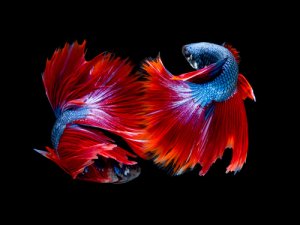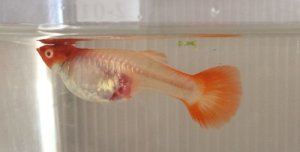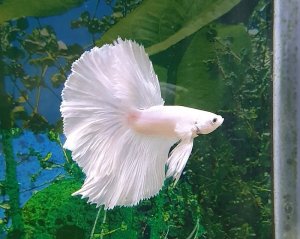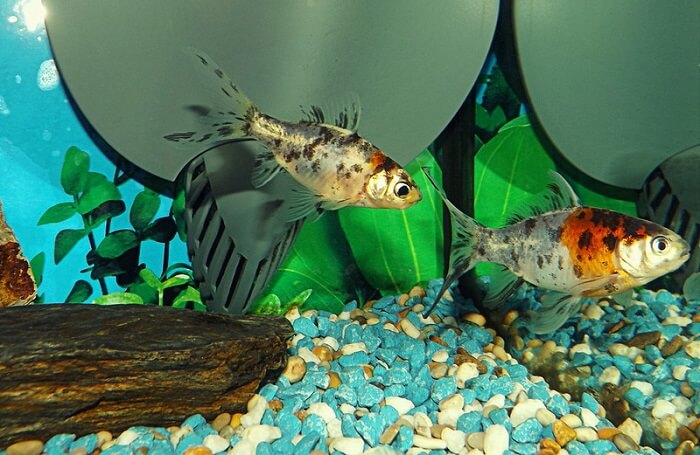
Breed Overview
| Origin | Japan |
| Lifespan | 15-20 yrs |
| Size | Max 12 inches/30 cm |
| Colour | Calico (nacreous with red/orange and black speckles) |
| Food | Omnivorous |
| Tank Size | Min 80 gallons/300 liters for 2 |
| Temperament | Active |
| Water Type | Freshwater |
| Water Temperature | 65-74 F/18-23 C |
| Water pH | 7-8 |
Species Summary
The shubunkin is a Japanese variety of goldfish with a name meaning ‘vermilion brocade’. It is known for its calico pattern and nacreous scales, a word describing an unusual color that comes from a term meaning ‘mother-of-pearl’.
Although your fish’s scales merely look similar to this precious substance, it’s safe to say shubunkins are a beautiful feature for any tank either way! The shubunkin is a recent breed and only originated in the 20th century from a wakin crossed with a demekin.
A Note About Shubunkin Goldfish Size And Setup
You may have heard that shubunkin goldfish can be kept in both a tank and a pond. In truth, these goldfish can grow pretty big when they have enough space and are well cared for. They can reach up to 12 inches or 30 centimeters when fully grown, and one of the best ways to encourage this is to give them ample space.
This guide mostly covers shubunkin care when kept in a tank, as this is more popular with beginner fish keepers. However, if you’re a more experienced aquarist, shubunkins can be kept in a pond in the same way as comet goldfish with very similar requirements.
Setting Up A Shubunkin Tank
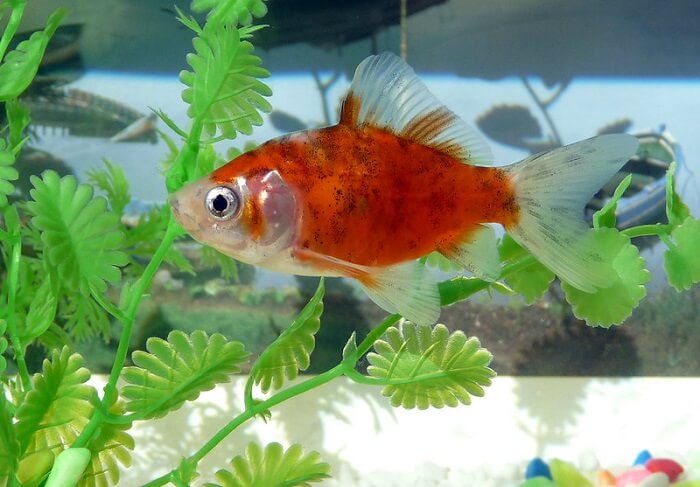
Tank Parameters:
- Ideal size: a tank for shubunkins should be large, approx 80 gallons/300 liters for a single pair of fish with an additional 10-20 gallons/38-76 liters for each extra fish.
- Suitable substrates: any substrate that plants can take root in, such as lava soil, is great as it prevents your fish from digging them up. On top of this, you can add another substrate for aesthetic purposes such as gravel.
- Filtration systems: A good filtration system with a flow rate of 5-10x your tank size is perfect for shubunkins as these are active fish that produce a lot of waste.
- Ammonia and nitrites: these should always ideally be at zero. However shubunkins can produce a lot of nitrates and if need be can tolerate up to 20 ppm
- pH level: 7-8
- Temperature: 65-74 F/18-23 C
- Lighting: an led light is good, but too bright light can make these fish lose their color due to the sensitivity of their nacreous scales. This can be amended by having a heavily planted tank or alternatively using green light or allowing the growth of algae on three of the four walls. Algae is also a good source of carotenoids, pigments that your fish can’t make by themselves and that are responsible for their color.
- Tank maintenance: Like with any goldfish the tank water should be changed once per week, removing a third and replacing it with fresh, filtered, dechlorinated water.
Tankmates
Mixed tanks can look amazing, but there are always important considerations before you set them up. The best tankmates for any fish tend to either share the same body type and habits, or are different enough that they don’t disturb each other.
Shubunkins can live with both comet and common goldfish in both tanks and ponds. It’s a good idea not to keep them with egg-shaped goldfish, or they will outcompete these.
Smaller fish and invertebrates are also a great choice of tankmates for your goldfish as provided you choose the right ones, they are different enough that they won’t compete with your goldfish.
Plants
Like mixed tanks, planted tanks are a joy to look at and have the added benefit of keeping water clean. Shubunkin goldfish can enjoy a wide variety of plants and in fact, a planted aquarium increases the amount of green light which can help these fish maintain their color. As the calico color and nacreous scales are more delicate than the metallic scales of most other goldfish, a planted tank therefore can shield your fish from the LED bulb.
So, How Big Do Shubunkin Goldfish Get?
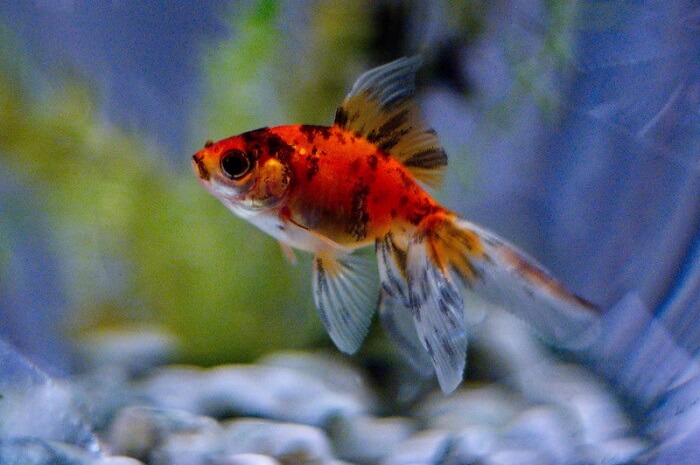
As we outline above, these fish can get BIG regardless of whether you keep them in a goldfish tank or a pond. The most surprising thing about shubunkin goldfish size is due to their delicate calico pattern, they may first appear to be fancy goldfish that don’t grow as big. In truth, these guys are more like the comet.
For your shubunkins to reach their full 12-inch/30 cm capacity it helps to have a big enough tank. Considering that these fish are happiest in groups, your setup may soon start becoming quite large. The ideal shubunkin tank is wider than it is tall, to maximize surface area and get oxygen into the water. The requirements for indoor tank size are just one reason why some fish lovers may choose to keep their fish in a pond instead.
Shubunkin Goldfish Varieties:
Now it’s time to take home your shubunkin! These beautiful fish are mostly known for being calico, but did you know the differences between the varieties? The American or Japanese shubunkin has a classic tail and body shape whereas the tail of the London shubunkin is a trailing fork like the comet goldfish. The Bristol shubunkin has rounder fins.
According to the breed standard, all shubunkins must have nacreous scales. This means they have a specific type of genetic mutation that gives the fish a distinctive look. It actually comes from the crossing of fish with metallic scales with fish with matte scales.
Variants of this can become even more striking with fish like the ghost bristol shubunkin, which has pink patches around its gills and very pale scales, the black opal shubunkin, and the midnight shubunkin. However, these variants are rare and the calico variation is most common.
Feeding Your Shubunkin Goldfish
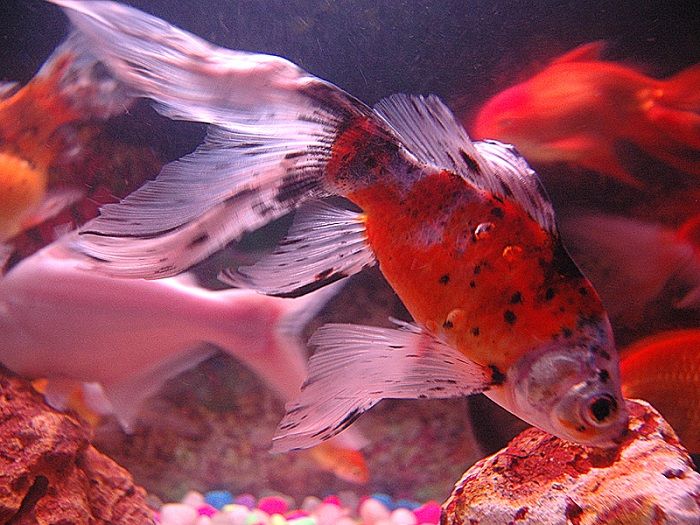
Feeding your shubunkins can be a breeze so long as you know how to put together a balanced diet. As active fish, they certainly appreciate a healthy, varied diet with both proteins and vegetables in addition to pellet food.
When choosing pellet food, choose sinking as opposed to floating pellets. Although these fish don’t have as sensitive a swim bladder as egg-shaped goldfish, and thus the risk from them gulping air from the surface while feeding on floating pellets is lower, sinking pellets give your fish plenty to find when they root around in their substrate. This helps keep them stimulated and allows them to extend their active personality as much as possible.
Protein:
- Tubifex worms
- Brine shrimp
- Daphnia
- Bloodworms
Vegetables:
- Half a shelled pea
- Small piece of cauliflower or broccoli
- Lettuce
- Sweet potato
- Alfalfa – this plant can actually improve pigmentation and growth
- Duckweed
Plants:
Shubunkin goldfish can eat a lot relative to their size. Plants can be a good source of additional food to keep your fish’s diet varied, and floating plants like duckweed can provide another source of stimulation. Sometimes if you are wondering why your goldfish is not eating, it can just be that they don’t like the food!
Spirulina:
You may occasionally see this supplement recommended and it can actually be found in many pellet foods. Spirulina can help with fish digestion and makes your fish’s colors more vibrant. However, it works mainly on the pigments responsible for the golden yellow colors most goldfish have.
Yet, even though they are calico, most shubunkins do have these, and pellet food containing spirulina can help ornamental fish look vivid and vibrant.
Temperament Of Shubunkin Goldfish
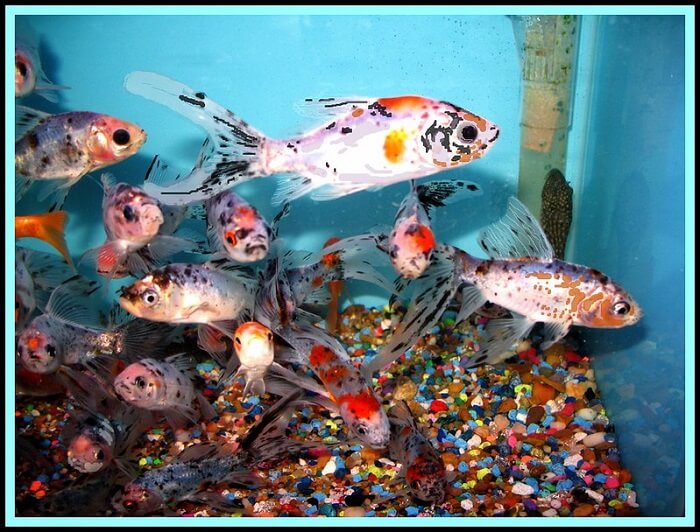
Shubunkin goldfish are very active and social fish that need to move around and explore. This is similar to the comet goldfish, which is why comet goldfish can make good companions, especially if you are planning on setting up a fish pond as opposed to a tank.
Likewise, the shubunkin goldfish is SMART. These fish can recognize their owners and will swim up to the glass for food, knowing when it’s feeding time. They are curious and will investigate the roots of plants, too. And they appreciate a varied tank that mimics the natural habitat of slow-moving streams and ponds that they would find in the wild.
Common Diseases Of Shubunkin Goldfish
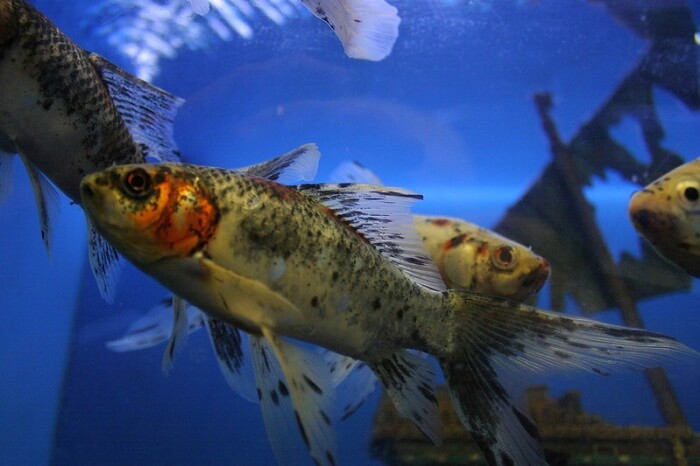
Black Spot Disease
Black spot disease is caused by a parasite and causes hard black spots to grow on your fish’s scales. Due to the shubunkin’s patterning, it’s good to learn to distinguish this disease from your fish’s natural coloration. Luckily, black spot is easily treatable with a saltwater bath to kill the parasite.
White Spot Disease
White spot disease is highly contagious between aquarium fish, so for the social shubunkin, it can be a potential problem. The key is to catch it early. Look for little white spots all over your fish’s body and fins. In shubunkins, these will be more visible on the orange-colored areas than on the nacreous scales. It can be treated with aquarium salt or over-the-counter medications.
Dropsy
Dropsy is a serious disease caused by an infection of the kidneys that means your fish’s body fills up with water. You will start noticing that your fish has trouble swimming, rolls from side to side in the water, and is lethargic. However, what indicates dropsy, as opposed to other signs your fish may be about to die is how the fish’s scales stick out like a pinecone.
With dropsy, prevention is better than cure. This disease is often a sign of poor water quality, so keeping your tank in tip-top shape will help prevent your fish from developing it.
Ammonia Burns:
Ammonia burns can affect any fish, but are important to look out for in shubunkin goldfish as they can be confused with your fish’s natural calico pattern. The key is that ammonia burns tend to come in big patches and you may wonder why your goldfish is turning black.
They don’t have the gentle dappled shape of typical black found within calico coloring. Instead, they may also have uneven edges. Therefore, if it looks like your goldfish is turning black, it’s important to test the water quality for ammonia as soon as you can.
Shubunkin Goldfish Breeding
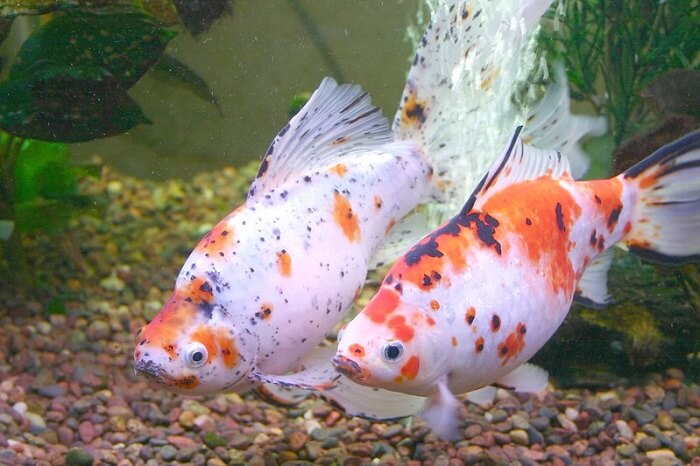
This unique fish’s genetics mean breeding offers a wealth of possibilities. Whether you’re new to breeding or are more experienced, these fish are hardy and easy to breed. Read on for some of the details.
Breed Standard Shubunkin Goldfish
It’s important to know whether you’re breeding your shubunkins professionally or just for pleasure as this sought-after variety of goldfish does have quite a firm breed standard. As a rule of thumb, a true shubunkin in calico, and a true shubunkin’s base color will be blue.
That being said, the shubunkin is also popular amongst breeders to give a calico coloring to other varieties of fish such as the comet goldfish, or even fancy varieties such as the fantail.
How to breed your shubunkin:
- Set up a spawning tank with a spawning mat or mop for your fish to lay their eggs in and slowly introduce your fish, ensuring to acclimatize them correctly.
- Using a tank thermometer, reduce the tank temperature of your fish’s current home to 50 F/12 C or so, which mimics the natural drop in temperature over the winter period.
- Gradually raise it again to 65 F/18 C over the course of a few days. The key word is ‘gradually’, as sudden temperature changes can shock goldfish, even hardy varieties like the shubunkin.
- Watch out for the female beginning to have a rounded abdomen. It can be hard to sex shubunkin goldfish but this is a good way of telling – in general, females tend to have rounder abdomens in general. The male may grow white tubercles on his gills like other goldfish varieties, but with the shubunkin sometimes this is missing.
- Like most goldfish, the male will chase the female until she drops her eggs, after which he will spray his milt and fertilize them. If you’re not familiar with how goldfish mate, look out for the male nudging the female.
- Always remove the parent fish after breeding! Goldfish eat their eggs and fry, so you won’t want to leave them in the same tank.
Final Thoughts
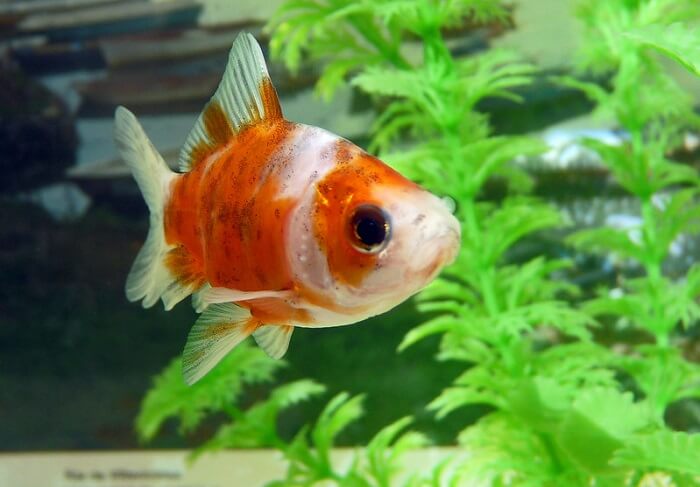
Shubunkin goldfish are a really great option if you want the look of a fancy goldfish but you’re not sure about their more sensitive requirements in terms of water quality. Their dappled, calico pattern is striking and always makes any tank look fantastic, but their wakin-like bodies mean they are easy to care for. Either way, these goldfish will provide spectacular and interactive pets for many years.


